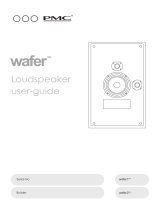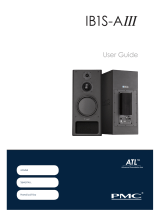Page is loading ...

TLE 1
Subwoofer User-Guide Version II

2
Product Support
For product support, accessories or servicing advice,
please contact a PMC authorised dealer.
Warranty
This product is warranted against defect of
manufacture and materials for a period of 5 years
from date of purchase.
Company Details
The Professional Monitor Company Ltd.,
43-45, Crawley Green Road,
Luton.
LU2 0AA.
United Kingdom.
Company Reg. Number: 3328009
T +44 (0) 870 4441044
F +44 (0) 0870 4441045
E sales@promonitor.co.uk
www.pmc-speakers.com
© 2003 PMC. All rights reserved.
Revision 1.1
This document should not be construed as a commitment on the
part of PMC. The information it contains is subject to change
without notice. PMC assumes no responsibility for errors that may
appear within this document.
General Usage Guidelines
1. Read these instructions and keep them in a
safe place for future reference.
2. Heed all electrical safety warnings,
including those on the sub-woofer itself.
3. Do not use the sub-woofer near water.
4. Clean only with a dry, lint-free, cloth.
5. Do not block the rear panel amplifier heat
sink.
6. Do not install near any heat sources such as
radiators, ovens or other equipment that
produce excessive heat.
7. This product is protected with a thermal cut
out. Should the back panel become too
hot, this will then cut the internal power.
Normal operation will automatically be
resumed, when the back panel has cooled.
8. Do not cut, replace or re-wire the supplied
mains cable, it is earthed for your safety.
Replacement cables of the same type can
be purchased from recognised electrical
retailers in a variety of lengths.
9. Provided it is correctly earthed, the type of
mains cable used does not have any
bearing on performance.
10. Protect the mains cable from being walked
upon or pinched.
11. An integral fuse, located alongside the IEC-
320 mains inlet protects the TLE1 from
voltage spikes and surges.
12. The integral fuse is type T2AL in 100-120volt
models and type T1AL in 220-240volt
models.
13. This product should only be used with the
same power source as indicated on the
rear panel label.
14. Unplug the sub-woofer during electrical
storms or when unused for long periods of
time.
15. Refer all servicing to qualified service
personnel. Servicing is required when the
apparatus has been damaged in any way
or exhibits a distinct or sudden change of
operation or performance.
16. Please retain all packaging in the event
that the unit needs to be shipped for
servicing.
17. Place all packaging in a safe place, out of
reach of small children.
18. When using the TLE1 with spikes ensure
there is no cabling (or feet!) underneath
that may be pierced by the spikes.

3
Introduction
Thank-you for purchasing a PMC TLE1, an audiophile sub-woofer design that is the re
sult of experience gained
in the professional audio production field, and research into the acoustics and ergonomics of the home.
Leading professionals such as BBC Radio and Television, Chesky Records, Dolby Laboratories, Granada
Television, LucasFilm, Dreamworks, JVC and Sony use PMC loudspeakers.
Size and aesthetics have played a major part in the creation of this radical new unit, evident in its tall slender
form and tiny footprint. The TLE1 is ideal for all domestic situations, especially those where
space is at a
premium and the user has a keen eye for design.
The two 170mm shielded custom drivers are driven by a true 150watt, ultra low distortion audiophile power
amplifier, based upon one of Bryston’s world-
class designs. In their Canadian facility, Bryston has been
designing state-of-the-
art specialty electronics for both the professional and consumer audio markets for over
twenty years.
Also within the elegant compact cabinet lies a true transmission line with an effective length of 3 meters, th
is
gives the TLE1 the ability to produce a flat frequency response down to 22Hz with real clarity and detail. The
PMC transmission line loading system provides a number of significant benefits over a standard 4th
order
ported or 2nd
order acoustic suspension (sealed) enclosure. They include dynamic, accurate and articulate
response at all listening levels, gradual low-frequency roll-off below the -
3dB point, ease of placement aiding
a consistent in-room response, extremely low output distortion, increased power and depth.
This purist approach to low frequency reproduction affords a unique opportunity for those who wish to enjoy
high-quality multi-channel music recordings as well as earth shaking Hollywood blockbusters.
Specifications
Frequency Response: 22– 250Hz in room.
Amplifier Power: 150watts RMS.
Amplifier Distortion: <0.009%, 20Hz – 20kHz (full output).
Amplifier Slew Rate: >60V per JS
Signal to Noise Ratio: 90dB ref. 0dBu.
Drivers: 2 × 170mm custom doped, magnesium alloy chassis.
Magnetically Shielded: Yes
Low-pass Filter: Continuously variable, 40Hz – 155Hz, 12dB per octave.
Phase Control: Continuously variable, 0° – 360°.
Low-pass Filter Bypass: Yes
Trigger Input: 12V AC/DC (continuous).
Unbalanced Inputs: 2 × Gold-plated RCA/Phono, impedance 20k.
Balanced Inputs: 2 × Gold-plated Neutrik XLR, impedance 20k.
Dimensions (W × H × D): 200mm × 550mm × 545mm. Spikes add >28mm.
Weight: 17.5kg.
Power Consumption: 180watts.
Thermal Cutout 80°C Auto reset.

4
Sub-woofer Connections
When selecting cables for use with your PMC sub-
woofer, ensure that they are adequately shielded, which is
particularly important if single-
ended runs are used and that their construction is of a high enough standard to
withstand the rigors of everyday use.
First, decide which type of input you will be using:
Balanced (XLR)
Input Selector: ‘BAL’ (switch in the out position. This can be found under the flap at the top rear of the unit)
The TLE1 can be connected to an amplifier, pre-amplifier, receiver or surround processor using balanced (XLR) inter-
connect cables. Balanced cables are recommended wherever possible due to their inherent superiority and noise
rejection, which is particularly important if long cable runs are required.
OR
Unbalanced / Single-ended (RCA/Phono)
Input Selector: ‘UNBAL’ (switch in the in position. This can be found under the flap at the top rear of the unit)
Single-ended (RCA) connections are still the most common method of routing signals from an amplifier, pre-
amplifier, receiver or surround processor to a sub-woofer. The hook-
up method is exactly the same as that for
balanced inter-connects.
Connect one end of each cable to your processor, receiver or amplifier and the other to the TLE1
Note: Both types of connection cannot be used concurrently.
Tip: An inexpensive length of RCA cable can be used when experimenting with sub-
woofer placement and then
replaced with balanced inter-connects – if supported by your hardware – once the final positi
on has been
determined.
Do I use both left and right inputs?
If your processor only provides one sub-woofer output – sometimes labelled “LFE” or “SUB” –
then a single balanced
or unbalanced cable can be used, connected to either the left or right input of the TLE1, it doesn’t matter which. If
a single unbalanced input is used, then it is recommended that the supplied RCA shorting plug is inserted into the
unused RCA socket. Stereo sub-woofer or stereo pre-amplifier outputs are also supported; requiring t
he use of two
lengths of cable (one for left, one for right), so that the sub-
woofer reproduces the bass information from both
channels.
If you are using the sub-woofer in a two-channel system, it can be connected to any available pre-
amplifier
output/s, provided the output is not of the fixed gain type (a tape record loop, for example).
Female
From source
Male
To TLE1

5
Trigger Input
The TLE1 has a standard 12volt AC or DC (constant) external control trigger. It can be used in conjunction
with a home automation system or suitably equi
pped processor to automatically enable or disable the TLE1
according to mode, source or mood.
To use the trigger, the rear panel mains power switch must be “ON” and the ‘Remote Power Control’ in the
“Remote” position. The trigger input uses a standard low-voltage 2.1mm DC jack.
If Remote trigger is not required, simply leave the “Remote Power Control” in the “Local” position, and use the
mains power switch, as normal
DC or AC
4-12V
Remote Power Control
Select ‘Local’ when not using
remote power control.
Power switch must be ‘on’ when
using remote power function
Local Remote
Mains power
switch
Fuse Mains input
Trigger input
connector
Remote power
control switch

6
Sub-woofer Set-up and Placement Guidelines
Sub-woofer integratio
n is of paramount importance in order to attain convincing music and movie
performance Motion picture soundtracks are mixed with the same care and attention as the finest
‘audiophile’ recordings on Compact Disc, SACD or DVD-Audio.
There are no hard and fast rules that will guarantee optimum performance, when it comes to sub-
woofer
installation, experimentation really is the key. It is a common misconception that sub-
woofers can be
positioned anywhere in a room; bass below 100Hz is omni-direction but respo
nse will differ according to
location. There follows a list of general guidelines one can follow in order to attain the best performance from
your system.
1. Set the controls of the TLE1 sub-woofer to neutral, i.e. volume control to its mid-point and roll-off ‘OFF’
(indicator LED green). In this state the sub-woofer’s integral low-pass filter is defeated.
2. Configure your receiver, processor or surround amplifier so that it’s sub-woofer output is enabled (for
all material) and defeat its own low-pass filter. If this is not possible, select the highest sub-woofer
crossover value available – commonplace options are 80, 100 and 120Hz. Refer to the user guide
supplied with your hardware for detailed instructions.
The purpose of steps 1 and 2 is to ensure the TLE1 receives the widest range of frequencies possible during set-
up. This is only a temporary measure; the configuration of system crossovers will be covered later in this user
guide. Nor are we concerned about the sub-woofer’s output level at this stage.
3. Disable all the system’s loudspeakers. In some cases this may not be possible, electronically, so we
advise temporarily disconnecting all applicable loudspeaker cables. Before doing so make certain
that all power amplifiers are ‘OFF’ and that no accidental shorting occurs.
4. Find a programme source with, solo acoustic double bass or bass guitar and set the system volume
to a comfortable listening level. Material with a tuneful bass-line is recommended.
From the primary listening position, concentrate
on the lower registers, remembering that the TLE1 is not
designed to reproduce high frequencies and that they will be absent during this test. The aim is to position
the sub-woofer in a location where the bass and mid-bass are neither woolly, compressed, over-
bearing nor
boomy, and where the response is at its smoothest and most consistent.
As a general rule of thumb, low frequencies are often reinforced when a sub-
woofer is positioned adjacent to
a boundary wall, but it’s important to remember that all r
ooms are different and that acoustics and their
interaction with your loudspeakers are the most influential factor on the performance of any system.
The TLE1 drivers can be orientated in any direction, but PMC recommends that the minimum distance
between the rear vent and a boundary, such as a wall, is 25mm (1 inch). Both the rear mounted vent and
amplifier heat sink require a free, circulating air.
Once in the optimum position the use of the supplied spikes is recommended to ensure the TLE1 remains as
st
able as possible. Pennies or spike ‘cups’ can be placed under the spikes to protect wooden flooring. The
supplied grille cloth is acoustically transparent and can be left in place at all times.
Note: The performance of your TLE1 will improve over the first few hours of use, as the close tolerance drivers
‘bed in’. Low frequency dynamics and bass extension are two areas that will benefit as the drive units reach
their optimum working condition.

7
Sub-woofer Controls
Having decided upon the optimum in-r
oom placement for the TLE1, its controls, in conjunction with those of
your amplifier, pre-amplifier, receiver or surround processor, are then used to integrate the sub-
woofer into the
remainder of your system.
1. Input Selector: (See page 4 for a description). ‘BAL’ (switch in the out position) is used with balanced
XLR inter-connects. ‘UNBAL’ (switch in the in position) is used with unbalanced RCA connections.
2. Roll Off Switch: ‘OFF’ (green LED illuminated) bypasses the TLE1’s own low-pass filter . This mode is
recommended when using an amplifier, receiver or surround processor which has built-in bass
management, usually with a dedicated “LFE” or “SUB” output, thereby avoiding potential filter
interactions. ‘On’ enables the low-pass filter and associated ‘Roll Off’ control. This mode is
recommended for two-channel use using available pre-amplifier output(s).
In most multi-channel installations, bass-
management within the decoding hardware is often preferred. For
example, selecting a 100, 80 or 60Hz cros
sover will route all bass to the TLE1 including that from other
channels. Some surround processors allow independent loudspeaker and sub-
woofer crossover frequencies.
In such cases it is important to avoid undue overlap (where the sub-woofer and any full-
range loudspeakers
reproduce the same frequencies), but bear in mind that the sub-
woofer channel of Dolby Digital, Super Audio
CD and DVD-Audio can contain significant energy up to and beyond 150Hz.
3. Roll Off Control: Adjusts the integral 12dB/octave low-pass filter. The ‘Roll Off’ control specifies the
point at which the TLE1 begins to attenuate frequencies above the set value, thereby blending its
response with the remainder of the system.
If you are using the TLE1 in a typical two-
channel system, or wish to simply reinforce low frequencies produced
by other loudspeakers in a multi-channel installation, then the use of the low-
pass filter ‘Roll off’ control is
advised. It should be adjusted by ear to the point where the TLE1 integrates seamlessly into
the system. I.e.
The subwoofer should only produce low frequencies that the main loudspeakers are not capable of.
4. Level Control: Adjusts the sub-woofer’s output volume.
For a wholly convincing experience, it is important that the output level of your sub-
woofer is correctly set.
While ultimately this parameter is a matter of personal preference, it is however advisable to begin from
known, calibrated level. Most amplifiers, pre-
amplifiers, receivers and surround processors include integral
calibration
noise. This is used to achieve the same output level from all the loudspeakers in a system. We
advise setting the decoder’s sub-woofer output level to its mid-
point (usually 0dB) and adjusting the level
control on the TLE1, this will later afford maximum flexibility of adjustments according to listening mode.
Follow standard calibration procedures using an SPL meter located at your primary listening position and set
to C-Weighting, ‘Slow’ response mode whenever possible. In a THX system, the output SPL
attained should be
75dB. In the absence of internal set-up noise, a recognised calibration DVD such as ‘
Avia: Guide to Home
Theater’ or ‘The Ultimate DVD: Platinum’ can be used.
5. Phase Control: Adjusts the phase relationship between the TLE1 and any other loudspeaker
reproducing the same frequencies. At 0° the TLE1 is electronically in-phase, at 180° electronically in
opposing phase.
The relative phase of a sub-woofer is a misunderstood and often over-
looked aspect of installation. It is the
relationsh
ip and interaction of the frequencies shared between the TLE1 and the other loudspeakers in your
system. As no bass-
management filter is a brick wall, there will always be overlap around the selected
crossover point. It is therefore important that the shared frequencies do not cancel one another, which is the
result of a sub-woofer that is not in phase. The relative phase of a sub-
woofer will depend on its position in the
room and its proximity to any other loudspeaker.
To set the phase value, listen to music with strong mid-
bass content such as kick drum and adjust the control
so that the combined output of the TLE1 and the remainder of your loudspeakers is at its loudest –
the use of
an SPL meter can help. Again, experimentation is the key, listen for tight, punchy and even bass response. NB
The effects of adjusting the phase can be extremely subtle in some environments.

8
Summary
• Select appropriate input depending on interconnects used. -Page 4.
• If required, connect up Trigger input and set “Remote Power Control” to “Remote”. -Page 4.
• Find the best location for your TLE1, following our guide. - Page 6.
• Fit spike s (recommended). - Page 6.
• Set the user controls for best tonal integration with the rest of your system. - Page 7.
• Congratulations; Your TLE1 is set up, so sit back, relax, and enjoy the experience!
The TLE1 has been designed to accompany many audiophile loudspeakers in both surround and stereo
configurations. To realise the ultimate in any format the following PMC products are engineered to interface
seamlessly in any environment.
DB1 Two way, Mini Monitor
DB1M-C Centre channel
TB2 Two way, Monitor
TB2M-C Centre channel
FB1 Two way, Floorstanding loudspeaker
For further information contact: sales@promonitor.co.uk or visit www.pmc-speakers.com
/










